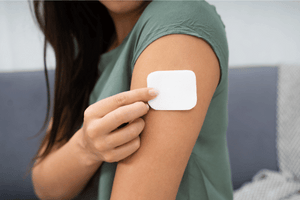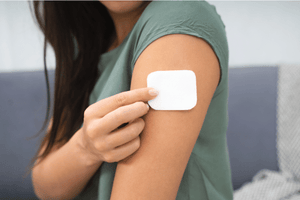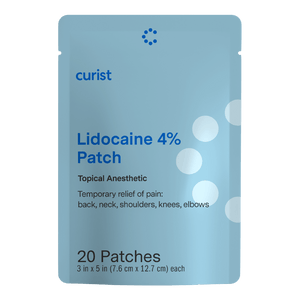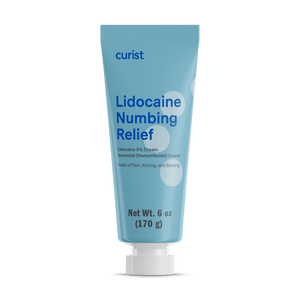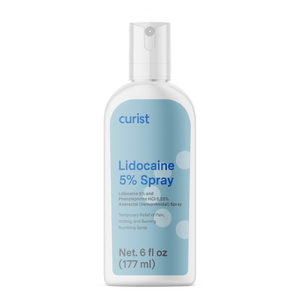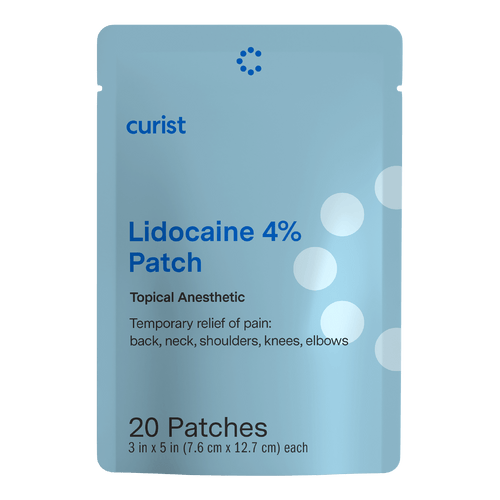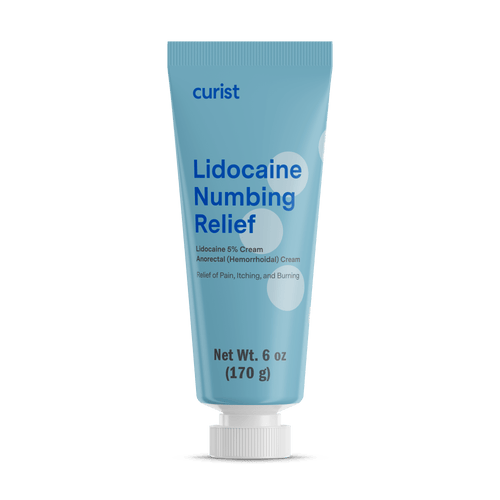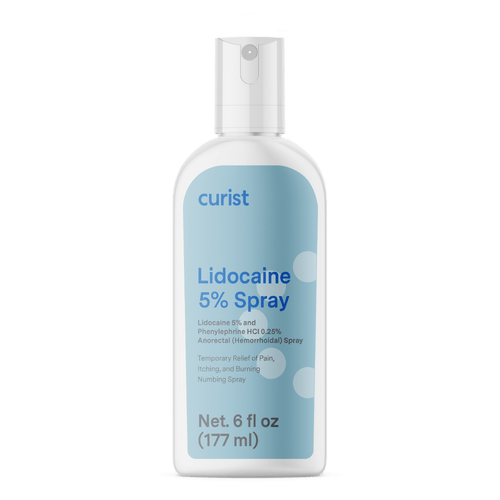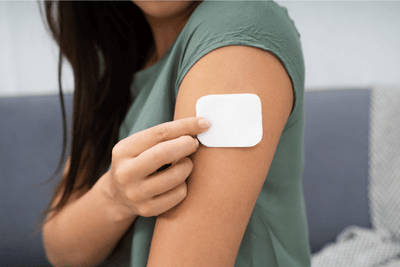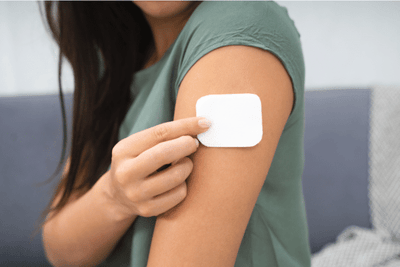By Ange Lu, PharmD
Curist delivers over-the-counter medicines to your door at a fraction of the price of traditional brands. We hope everyone stays safe and healthy during this time.
Lidocaine and menthol are two of the most popular products for pain relief. Let’s break it down to see which one would work best for you!
What is Lidocaine? How Does Lidocaine Work? What is Lidocaine Used For?
Lidocaine is a local anesthetic that comes in different forms and strengths to help relieve pain. When applied, it reduces feeling in that area by blocking the signals to your nerves and causing a numbing effect. Because it is a local anesthetic, lidocaine can only cause a numbing sensation in the area where it is applied on the body. It is also important to note that lidocaine will only relieve symptoms of pain. It will not treat the underlying condition, so always consult with your doctor to find the best treatment plan for you.
Depending on the strength and form, lidocaine can come as a prescription or over-the-counter product. It can be used for different types of pain relief based on its strength. A lidocaine 4% patch can help with minor muscle aches and nerve pain from shingles on your back, neck, shoulders, arms, or legs. Lidocaine 4% cream is often used for pain and itching caused by minor burns, scrapes, insect bites, or poison ivy. Lidocaine 5% cream can be used to reduce itching and pain caused by hemorrhoids. A viscous lidocaine 2% solution can help with mouth sores and can reduce gagging during dental procedures. Lidocaine’s uses vary by product, so always refer to the manufacturer’s labeling.
What is Menthol? How Does Menthol Work? What is Menthol Used For?
Menthol is an organic compound made from the oils of mint plants, such as peppermint or spearmint, and comes in a variety of strengths. It can be found over-the-counter as gels, creams, lotions, liquids, spray, patches, or lozenges, and it can sometimes have a strong odor after it is applied. Menthol is a counterirritant and acts on the cold receptors in the sensory nerves of your skin. Counterirritants such as menthol cause the cooling sensation you feel when they are applied topically and distracts the brain from the painful area.
Menthol is often found in cosmetics or medications for pain relief and respiratory conditions. Topical menthol is primarily used to relieve minor aches and pains in your muscles or joints from arthritis, backaches, strains, or cramps. Menthol can also soothe strains, sprains, and skin irritation from bruises, minor cuts, insect bites, and sunburns. Menthol lozenges can be used to provide temporary cough relief during a cold to help sleeping at night. Topical menthol is often combined with other products to increase the absorption of other topical medications, such as lidocaine or camphor. Some studies suggest that it can even help heal wounds on the skin!
What’s the Difference Between Lidocaine vs Menthol?
Lidocaine and menthol are both used to help relieve pain, but they do so in different ways. Lidocaine is a topical anesthetic that acts locally on your skin to block the signals to your nerves and cause a numbing effect. Depending on the strength and form, it can help relieve pain and itching caused by hemorrhoids, muscle aches, or minor joint pain.
Menthol is a counterirritant and causes a cooling sensation on your skin to distract your brain from the underlying pain. It can temporarily relieve aches in your muscles and joints, itching from skin irritation, and minor throat irritation from coughs during a cold. Topical menthol is often combined with other products and used as a permeability enhancer to increase the absorption of other topical medications, such as lidocaine or camphor. Menthol can sometimes have a strong odor after it is applied.
Is Lidocaine Stronger than Menthol? Is Menthol Stronger than Lidocaine?
There is currently limited evidence that lidocaine is stronger than menthol or that menthol is stronger than lidocaine. Individual studies have suggested that lidocaine and menthol are similarly effective in reducing pain symptoms. Lidocaine and menthol work best when they are paired together. This is because menthol works as a permeability enhancer to increase the absorption of other medications. According to one study, over-the-counter lidocaine 3.6% combined with menthol 1.25% was just as effective as prescription lidocaine 5% with similar side effects.
Lidocaine vs Menthol: Which is Better for Muscle Pain?
The best product to use for muscle pain relief depends on the type, location, and intensity of your pain. If you have a muscle strain or minor sprain, a topical counterirritant like menthol may work for you. If you are experiencing localized pain in your muscles in your shoulders, back, neck, elbows, or knees, a lidocaine 4% patch may work better for you.
It is important to keep in mind that lidocaine and menthol only act locally on the area you applied the product to and do not provide anti-inflammatory properties or treat the underlying condition. If you experience pain throughout your whole body or feel pain due to swelling and inflammation, a non-steroidal anti-inflammatory medication such as ibuprofen may be more effective.
Lidocaine vs Menthol: Which is Better for Neck Pain?
Lidocaine is better than menthol for neck pain. It blocks the signals to your nerves to cause a numbing effect. According to the Centers for Disease Control and Prevention (CDC), lidocaine patches are recommended for subacute and chronic pain conditions. Curist’s lidocaine patch is flexible, easy to use, and works locally at the site to provide fast-acting pain relief. Lidocaine 4% patches are also less costly than their stronger prescription counterparts.
Lidocaine vs Menthol: Which is Better for Back Pain?
Lidocaine is better than menthol for back pain. The CDC lists lidocaine as one of the medications patients can use for subacute and chronic pain. Lidocaine works to numb pain by blocking the transmission of pain signals to your nerves. Curist’s lidocaine patch can provide effective pain relief for your back at an affordable price.
It is important to note that the lidocaine patch should not be applied over damaged skin, used with other topical analgesics, or used with a heating pad. These factors may change the absorption of lidocaine into your body and cause serious unwanted side effects.
What’s the Difference Between Lidocaine Patches vs Menthol Patches? Which is Better, Menthol Patches or Lidocaine Patches?
You should use a lidocaine or menthol patch based on the type and location of your pain. Patches often provide longer lasting relief compared to other formulations, but they may fall off during exercise or if exposed to damp or wet skin.
Lidocaine patches can be used for pain relief in your muscles or nerve pain caused by shingles. Lidocaine 4% patches can be found over-the-counter and are used to relieve pain in your back, neck, shoulders, knees, and elbows. In contrast, a lidocaine 5% patch is used for nerve pain and will need a prescription from your doctor. Lidocaine patches are generally well-tolerated and can be used for up to 12 hours, but they may cause skin irritation at the site of application. Lidocaine patches act locally on the area where they are applied and should not be used if you have pain in your whole body or multiple areas of your body.
Menthol patches can be used for muscle aches, strains, sprains, bruises, or cramps. Similar to lidocaine patches, menthol patches work locally on the applied area and should not be used if you are experiencing pain in multiple areas in your body. Menthol patches are found over-the-counter and are generally well-tolerated. They can only be used for up to 8 hours and for no more than 7 days at a time. However, a menthol patch may cause irritation locally and if it makes contact with your eyes. Learn more about how the lidocaine patch compares to Icy Hot patches and Biofreeze patches.
What’s the Difference Between Lidocaine Spray vs Menthol Spray? Which is Better, Menthol Spray or Lidocaine Spray?
You should use a lidocaine or menthol spray based on the type and area of your pain. With sprays, you will not have to touch the medication or the painful area during application, but you may need to reapply it multiple times throughout the day. Additionally, make sure to shake the container before spraying and only use it over a localized area.
When formulated at the 4% strength, lidocaine 4% sprays can be used for pain relief caused by sunburns, insect bites, or minor scrapes and cuts. Lidocaine sprays can be found over-the-counter and can be used multiple times per day. It is important to first clean your injuries with mild soap and water before drying and applying the lidocaine 4% spray. At a higher strength, lidocaine 5% sprays can be used to treat hemorrhoids and other anorectal conditions. Unlike lidocaine 4% sprays, lidocaine 5% sprays should not be used for topical applications, like for sunburns, insect bites or minor scrapes or cuts. For instance, Curist Lidocaine 5% Spray with Phenylephrine can be used to treat hemorrhoids.
Menthol sprays can be used for muscle aches, strains, sprains, bruises, or cramps. Menthol 10.5% spray can be used in adults and children older than 12 years old and can be used up to 3 to 4 times per day.
What’s the Difference Between Lidocaine Cream vs Menthol Cream? Which is Better, Menthol Cream or Lidocaine Cream?
You should use a lidocaine or menthol cream based on the type and location of your pain. Creams are easy to rub on to the affected area and dry quickly, but they can accidentally be wiped off and require direct application. Always wash your hands before and after applying lidocaine or menthol cream, and make sure to wash and dry the area before applying the cream as well.
Lidocaine 5% creams are used for pain, itching, and burning caused by hemorrhoids and other anorectal irritations. Lidocaine cream can be used multiple times per day and applied externally to the affected area. It should not be pushed into the rectum with fingers or another applicator. It is important to avoid contact with the eyes and discontinue if rectal bleeding occurs.
Menthol creams can be used for muscle aches, strains, sprains, bruises, or cramps. Menthol creams should only be applied on local aches and pains and should not be used to treat whole body aches. It can be used up to 3 to 4 times per day.
What’s the Difference Between Lidocaine Roll-On vs Menthol Roll-On? Which is Better, Menthol Roll-On or Lidocaine Roll-On?
You should use a lidocaine or menthol roll-on based on the type and area of your pain. Roll-ons are portable, involve little mess, and dry quickly. However, they may require multiple applications throughout the day and need direct application. Roll-ons are great if you want to apply lidocaine or menthol onto a very small area.
Lidocaine 4% roll-ons can be used externally for minor pain relief in the arms, legs, back, or neck. Lidocaine roll-ons can be applied to the affected area every 6 to 8 hours, but not more than 3 to 4 times per day. Once applied, it should be massaged in until the lidocaine is thoroughly absorbed into the skin, and your hands should be washed with soap and water after each use. Lidocaine roll-ons should not be used on large areas of the body, on wounds or damaged skin, or with a heating pad.
Menthol roll-ons can be used for muscle aches, strains, sprains, bruises, or cramps. Menthol roll-ons can be applied to the painful area no more than 3 to 4 times per day. It is important to wash your hands with cool water after every use and avoid bandaging the area tightly.
Can Lidocaine and Menthol be Used Together?
Lidocaine and menthol can be used together. In fact, there are already many products that contain both ingredients for you! Menthol increases the permeability of your skin. That means it increases the absorption of other topical medications more effectively, so you can get greater pain relief at a lower dose.

